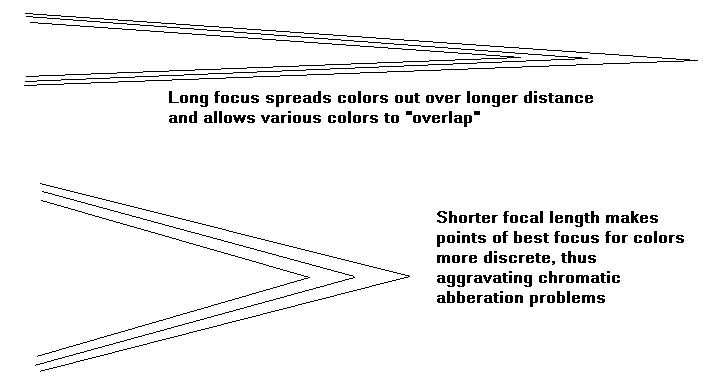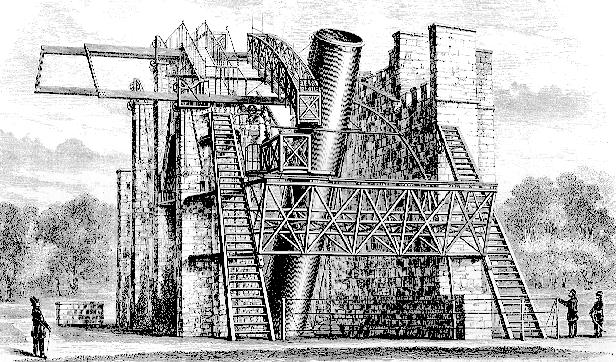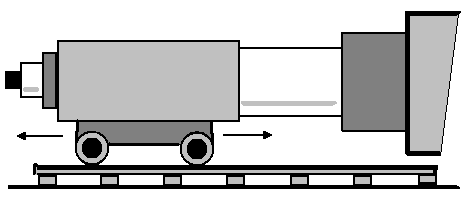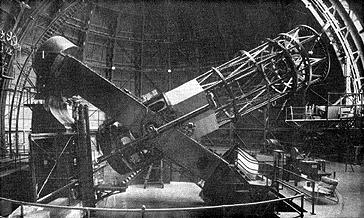A Short History of the Telescope
Jack Kramer
Galileo did not invent the telescope -- he simply knew how to take advantage of a good thing! The telescope was really invented by the Dutch spectacle maker, Jan Lipershey, and first used to spy on foreign ships.
When he conducted his observations in the early 1600's, Galileo primarily used two telescopes; each had a double-convex lens in front, and an eyepiece that was a single double-concave lens. One had an objective of 26mm with a focal ratio of f/51, giving 14 power, and the other had a 16mm objective at f/61, which gave 21 power. Those familiar with optics will realize that these designs provided ridiculously narrow fields of view by today's standards. Modern day analysis of his lenses shows they had a surprisingly good figure; however, the images suffered because the clarity of the glass at that time was poor. As a result, images were never really sharp. This explains why Galileo did not understand the nature of Saturn; to him it appeared simply as a curious oblong blob.
Johannes Kepler is credited with redesigning the eyepiece to make it convex, rather than concave, thus widening the field of view. The division in Saturn's ring-system was first recorded in 1675, and five of its moons were discovered between 1655 and 1684. Apparently, telescopes by this time were able to resolve to nearly one arc-second.

Despite improvements in the quality of optical glass, there was still the problem of chromatic aberration -- the colored glow around bright objects.
Our eyes are most sensitive in the yellow part of the spectrum at almost the exact frequency that the Sun radiates most strongly. A simple lens can sharply focus a maximum of two colors at a time. Therefore, we tend to focus on the colors yellow and green. Colors on each of the opposite ends of the spectrum -- red and blue-violet -- are out of focus, so objects have a purple halo.
Telescopes at this time had to have very long tubes. In addition to increasing magnification, a longer focal length tended to minimize the aberration. Plus there was the difficulty of generating the deep curve required for a shorter focal ratio.
Though we associate Isaac Newton with the reflector, it was the Scottish mathematician, James Gregory, who first announced in 1663 his invention of a telescope that used mirrors. It did two things: the problem of chromatic aberration was eliminated and there was provided a means to dramatically increase light gathering. Nonetheless, telescope makers were hampered by a lack of suitable material. The speculum metal used for the mirrors wasted much of the available light -- they simply weren't very reflective, and they required a great deal of maintenance.
While some telescope makers worked on improving the reflector, refractors remained smaller but the quality of their images made them the choice for major observatories. In the late 1700's, a major improvement occurred as a result of John Dollond's development of an achromatic ("non-chromatic") lens system for refracting telescopes. Typically, two separate lenses are used for the objective, one of crown glass and the other of flint. Flint is softer, so it was generally the element that faced the inside of the telescope. Chromatic aberration in refractors was now greatly diminished.
Charles Messier provides a good example of the situation at this time. During the period from 1765 to 1807, he used both refractors and reflectors. For awhile, his favorite was a 7.5-inch Gregorian reflector with a focal length of 32-feet, giving a magnification of 104x. Because of the speculum metal mirror, however, this provided light gathering equivalent to only about a 3.5-inch refractor. Messier later did adopt a 3.5-inch achromatic refractor giving 120x. Though his records list many telescopes, seldom is the aperture shown, only the focal length and magnification. Apparently, the interchangeable eyepiece was not common at this time. Surely, astronomers must have been aware of the connection between aperture and light-gathering. The fact that Messier seldom mentions aperture might be due to the fact that the technology wasn't able to produce consistently good large optics; therefore, aperture was of secondary importance. The size of Messier's telescopes should give some encouragement to those who set out to find all the Messier objects using modest instruments.
In 1789, William Herschel constructed a 48-inch reflector, and around 1840, the Earl of Rosse built his giant telescope with a 72-inch mirror. Despite these advances, major observatories before the 20th century still preferred refracting telescopes because of their image quality. Another major concern was that the configuration of the large reflectors and the manufacturing capability of that time created some unwieldy mechanical and observer-access problems.

By the late 1800's, optical glass for large refractor lenses had improved markedly. Several telescope makers had achieved renown for the quality of their instruments -- they included the famous names of Clark, Brashear, and Mogey.Most major discoveries before the 20th century were made using refractors. For example, it was with the Lick 36" refractor that E. E. Barnard discovered the fifth moon of Jupiter in 1892, at last expanding beyond the four originally found by Galileo. As late as 1930, Pluto was discovered with the Lowell Observatory 13-inch refractor.The epitome was reached with the 40-inch at Yerkes Observatory, which was completed in 1897 and housed in a dome 90 feet in diameter. Alvan Clark, who made the 40-inch lens, felt that a still larger refractor would be impossible because the weight of the glass would cause the lenses to sag and lose their figure. Unlike a mirror, a lens can only be supported around its circumference.
But the Yerkes telescope was not the largest refractor ever built. The largest was constructed for the Paris Exposition of 1900. It had a 49.2-inch objective with a focal length of 187-feet. With this focal ratio (f/45.6), the lowest magnification was 500x! Even its mounting was unconventional. It was mounted horizontally using a siderostat mirror of 79-inches to feed the object to the primary lens. Focusing was done by means of a carriage on rails, with a focus travel of 5 feet. But the results were poor, owing to a bad location and a steel tube with no ventilation. The telescope would not fit under a conventional observatory dome and after the year-long exposition was over, its builders were unable to sell it to any institution. The telescope was ultimately broken up for scrap.

The later history of the telescope certainly belongs to the reflector. By 1900, most astronomers preferred reflectors for their ability to be made quite large, thus providing much more light gathering. As they probed the
edge of the universe, it became clear that the future of astronomy would be tied to the reflector. However, there were still some problems. By the 1850's, speculum metal mirrors had been abandoned in favor of glass, but plate glass was unstable, and as such, it was difficult to figure. Then once the mirror was installed in the telescope, the figure again changed with changes in temperature. The invention of Pyrex glass largely solved these problems. But there was still the difficulty of casting large mirror blanks, as exemplified in the story of the 200-inch Hale telescope.
The Hooker 100-inch reflector at Mount Wilson is an example of the new generation of instruments in the twentieth century. It was completed in 1917, but its primary mirror maintains a tie with the past. The mirror blank was cast by the St. Gobain Glass Works in France. Throughout its history, this firm had derived much of its revenue from the production of the green-colored bottles used to protect vintage French wines. Not wanting to depart from tradition, the mirror for the 100-inch was cast out of green glass!

Among its accomplishments, in 1920, the 100-inch was used to pioneer the technique of stellar interferometry using coordinated observations from widely separated telescopes to examine the features of stars to unprecedented levels of detail.
Despite the increase in light gathering ability, mirrors still were unable to maintain a perfect image over the entire field. Today, active optics provide the best possible image by slightly changing the figure of the mirror to compensate for atmospheric effects.
An important part of the history of the telescope involves the sites where they were built. Especially with the coming of the large reflectors, it was realized that the location of the telescope plays a critical role in the performance of the instrument. Yerkes was the last major observatory to be constructed near sea level. The Lick Observatory 36" refractor had been installed on Mount Hamilton in California, and this signaled the migration to mountaintops that was to come. Mount Wilson now suffers from the light pollution of Los Angeles, but the quality of the seeing there is still regarded among the best at any of the observatory sites.
The development of large refractors came to an abrupt end with Yerkes. But not all the telescopes of the past have been relegated to serving as museum pieces. Some are still used for important research work where image quality is especially important. In studies of the cosmic distance scale, traditional measurements of the distances to stars are unreliable beyond 100 light years. Trigonometric parallax is the most precise method of measurement, and the rest of the distance scale is built off it. At this scale, angles are very difficult to measure, so the Allegheny Observatory 30-inch Thaw refractor has been fitted with equipment for multichannel astrometric photometry in order to measure parallax to an unprecedented accuracy of 1 milliarcsecond.
The Yerkes 40-inch has done spectroscopic work and photometry, which is the direct measurement of photons to create intensity traces that are used to measure star magnitudes precisely to 0.01 magnitude. The 40-inch has also re-photographed stars that were originally photographed around 1910 to see how much they have moved in the intervening years. By using the same telescope over a long span of years, the image scale remains the same so that the positions of stars can be measured with significantly higher precision.
At Mount Wilson, the Hooker 100-inch reflector has been pulled out of mothballs to be used for remote imaging and binary star speckle interferometry, a cutting-edge way to measure the magnitudes and colors of individual binary stars. It's finding renewed usefulness in the study of point sources such as individual stars and clusters, and in solar system work where objects are not as severely affected by light pollution.
This article has chronicled the development of lens and mirror-based telescopes as each reigned as the instrument of choice. Of course, space limitations here simply don't permit a thorough coverage of the subject, so many highlights were omitted. There have been a number of design variations on the traditional refractor and reflector. The important point is that telescopes are a technology with great longevity. Many of the good old telescopes that survive -- whatever their design -- can still be useful instruments to this very day.





